game maker disable 3d drawing
Let's say that you lot take a sprite with a circuitous animation (i.eastward. variable frame rate). As you lot can run across from the following prototype, each frame will play at a specific fourth dimension (I use a uncomplicated Photoshop script to consign the frames, I'll write an article virtually it later).
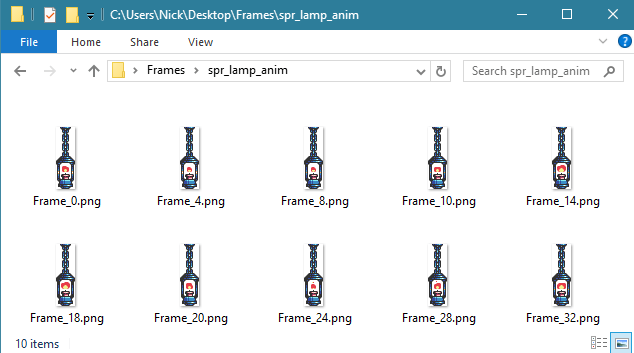
A simple cord
If you look closely, each filename already encodes the information about its own animation timing. What if nosotros could draw the animation with a unproblematic string? Something like this:
var animation_string = "00001111223333444455666677778888"
Each number, represents the sub-image to draw. Each number'southward position inside the string, stand for the timing. Equally you can see this poses 2 issues:
- Currently, with my Photoshop export script, I don't take whatsoever information about the duration of the last frame. It'southward non encoded anywhere because there is no such data in the Photoshop exported files to begin with. I notwithstanding don't know how to solve this problem. Information technology's not a big deal though; I manually fill in the last frame information.Since I know the last frame'south elapsing, I manually edit the string from
var animation_string = "00001111223333444455666677778888"
to
var animation_string = "000011112233334444556666777788889999" - If we use only numbers from 0 to nine to encode them, we can theoretically store but upwardly to 10 different frames. This can hands be solved though.
Mapping more than than ten different frames
To get beyond 10 frames, we could theoretically employ the hex lawmaking. Nosotros could indeed encode 16 different frames (from 0 to F). But who said we should limit ourselves to hexadecimal codes? Allow's extend the same concept to apply all the alphabet… and then some…
I use the following GML script to map single characters to integers:
/// @desc Return an int value from a pseudo-hex (custom extended-hex) char. /// @func scr_exhex_to_number(exhex_char) /// @writer Nikles /// @version 1.i /// @arg exhex_char The "extended hex" graphic symbol to interpret switch (argument[0]) { case "0": render 0; case "1": return 1; case "2": render 2; instance "3": return three; instance "4": return 4; case "5": return 5; case "vi": render 6; case "vii": return seven; case "eight": return 8; instance "nine": return ix; case "A": return 10; case "B": render eleven; example "C": render 12; case "D": return thirteen; instance "E": return fourteen; case "F": render 15; example "G": return xvi; example "H": return 17; case "I": render 18; case "J": render xix; case "K": return twenty; case "50": return 21; case "G": return 22; case "Northward": render 23; case "O": return 24; case "P": return 25; case "Q": return 26; case "R": return 27; example "S": return 28; example "T": render 29; instance "U": render 30; instance "5": return 31; instance "W": return 32; example "X": return 33; instance "Y": return 34; example "Z": render 35; case ",": return 36; case ";": return 37; instance ".": return 38; instance ":": return 39; case "-": return 40; instance "_": return 41; case "|": return 42; instance "!": return 43; case "£": return 44; example "$": return 45; example "%": return 46; instance "&": return 47; case "/": return 48; instance "(": render 49; case ")": return 50; instance "=": return 51; case "?": return 52; instance "'": return 53; case "^": return 54; instance "*": return 55; case "]": return 56; case "[": return 57; case "{": render 58; case "}": render 59; default: return -1; } With the in a higher place script I'm able to map sixty dissimilar frames to threescore different chars. That's nice but how exercise I utilize information technology?
Usage
In the CREATE event of the animated object I can apply this simple code:
// Ready blitheness timeline and animation length image_speed = 0 // Stop the GMS2 standard animation playback animation_string = "00001111222233445566778899AABBCCDDEEFFFFGGGGHHHHIIIIJJJJ" animation_len = string_length(animation_string) animation_index = one // Starts at 1
- Stop playing the standard GameMaker animation setting the
image_speed = 0 - Set the animation cord, containing all the information about which frame should play at a specified time (time is the position within the string, btw).
- Calculate the duration of the animation (which is basically the length of the
animation_string) - Set the starting
animation_index = 1. Information technology's important to outset at 1 and not 0 because of how GameMaker Studio 2 works with cord indexes.
You can copy the code (and adjust it to your needs). Just brand sure to employ your own strings for your own sprites/animations 🙂
In the Stride consequence I identify this code:
// Become the correct frame animation_image = scr_exhex_to_number(string_char_at(animation_string, animation_index)) // Increase Animation "Timer" animation_index++ // Loop Animation if animation_index > animation_len animation_index = 1 // Uncomment if you don't use a custom depict event // image_index = animation_image
- become the electric current animation frame using the
scr_exhex_to_numberscript. - to practice then, become the character of the string representing the current, encoded frame (
string_char_at(animation_string, animation_index)) - increase the
animation_index(then the side by side pace I become the next grapheme) - if it reached the finish of the blitheness, loop it.
I can and then use a custom DRAW event with a draw_sprite_ext call or override the image_index with the animation_image.
GML code generation with Python three
Let's be serious: I can't write those strings manually each time. I mean… ok, I might still need to manually make full the final frame duration info, but creating the whole strings from scratch, for many different sprites, looks similar difficult work.
Let'south automate. With Python iii.
import glob index_to_exhex = { 0: "0" , one: "1" , 2: "ii" , iii: "3" , 4: "4" , 5: "5" , half dozen: "6" , 7: "vii" , eight: "8" , 9: "9" , ten: "A" , 11: "B" , 12: "C" , 13: "D" , 14: "Due east" , 15: "F" , 16: "Yard" , 17: "H" , xviii: "I" , xix: "J" , xx: "K" , 21: "L" , 22: "M" , 23: "N" , 24: "O" , 25: "P" , 26: "Q" , 27: "R" , 28: "Due south" , 29: "T" , 30: "U" , 31: "Five" , 32: "Due west" , 33: "10" , 34: "Y" , 35: "Z" , 36: "," , 37: ";" , 38: "." , 39: ":" , 40: "-" , 41: "_" , 42: "|" , 43: "!" , 44: "£" , 45: "$" , 46: "%" , 47: "&" , 48: "/" , 49: "(" , 50: ")" , 51: "=" , 52: "?" , 53: "'" , 54: "^" , 55: "*" , 56: "]" , 57: "[" , 58: "{" , 59: "}" } folder = r'.' folders = glob.glob(folder + "\*\\") with(open(folder + '\\anim.txt', 'a')) as out: print("""if !variable_global_exists("ds_animation_strings") || !ds_exists(global.ds_animation_strings, ds_type_map) { variable_global_set("ds_animation_strings", ds_map_create()); } """, file = out) for _folder in folders: sprite_name = (_folder[:-1].rpartition("\\")[-ane]) frame_files = glob.glob(_folder + "\*.png") frame_list = [(filename.rpartition('_')[-1][:-iv]) for filename in frame_files] frame_list.sort(central=int) with(open(folder + '\\anim.txt', 'a')) as anim: index = 0 prev_frame = 0 anim_string = "" for frame in frame_list: if int(frame) == 0: prev_frame = 0 index+=i go on else: frame_list = [(index_to_exhex[index - 1]) for i in range(prev_frame, int(frame))] anim_string += ''.bring together(frame_list) prev_frame = int(frame) index+=1 print("ds_map_replace(global.ds_animation_strings, \"" + sprite_name + "\", \"" + anim_string + "\")", file = anim) I have that Python script in a file called anim_string.py.
Now let's say that I have multiple folders. Each of them named as the final sprite in the GMS2 project. What if I could generate GML code for each sprite, automatically, without having to write the blitheness strings by myself?
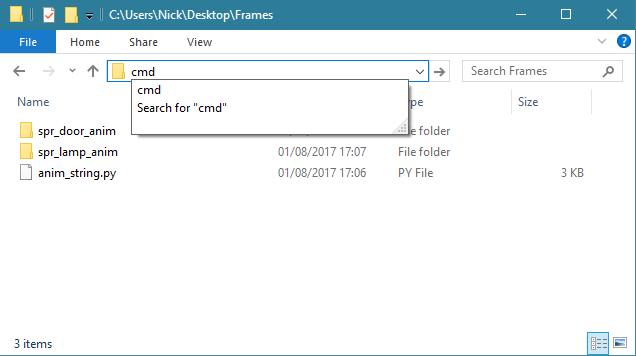
I then blazon cmd in the address bar to open up a command prompt.
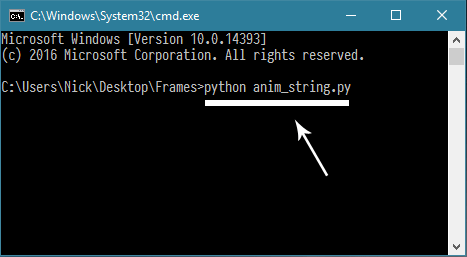
I execute the script and close the prompt. An interesting text file will appear.
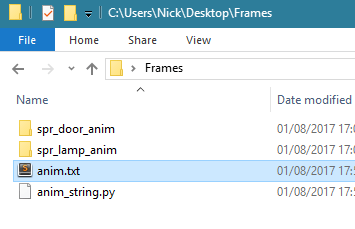
I open up it and just copy thisGML code to utilize in GameMaker Studio ii:
if !variable_global_exists("ds_animation_strings") || !ds_exists(global.ds_animation_strings, ds_type_map) { variable_global_set("ds_animation_strings", ds_map_create()); } ds_map_replace(global.ds_animation_strings, "spr_door_anim", "00001111222233445566778899AABBCCDDEEFFFFGGGGHHHHIIIIJJJJ") ds_map_replace(global.ds_animation_strings, "spr_lamp_anim", "00001111223333444455666677778888") I and so add the final frame animation info by hand and I get this:

I run this GML code but once at the beginning of the game (e.g. in the create event of my controller object). The following happen:
- a global variable called
ds_animation_stringsgets created - an empty
ds_mapgets assigned to that variable - the
ds_mapgets filled with the animation strings of my sprites
I then use a slightly differentCREATE event for my objects to make use of the global ds_map I created.

The STEP consequence remains the same:
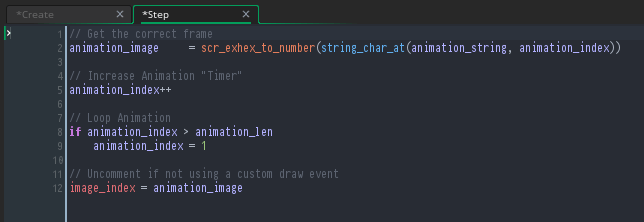
Things to remember
There are a few things to deport in heed, though:
- Unless your Photoshop exports use the same filename scheme (
Frame_X.png) the Python script won't work for you (if at that place's asking, I will publish an article most it as well). - This system works equally long as the object'due south sprite you're importing has the same name every bit the subfolder. Information technology'due south like shooting fish in a barrel to edit the scripts though, then… non a large bargain.
- I created two different GML scripts for the CREATE and STEP result, and simply telephone call them (instead of writing the aforementioned lawmaking over and over in each object that needs this system).
- If I edit the GML mapping script, I need to edit the Python script equally well. The mapping should plain be the aforementioned.
- Remember that I yet NEEDto fill in the Last FRAME duration info past hand. For each sprite (way meliorate than writing the whole damn strings though).
What's side by side?
I really don't know if people are interested in such tricks. If and then, permit me know. I could write an commodity almost how I export my Photoshop files (and get that precise naming scheme for my .png files).
Permit me know in the comments if you call up this is overkill or if you want more (also if you find bugs). And forgive me for the horrible (only working) Python script.
Source: https://nikles.it/2017/gamemaker-tutorial/advanced-animation-control-in-gamemaker-studio-2-method-1/
0 Response to "game maker disable 3d drawing"
Yorum Gönder